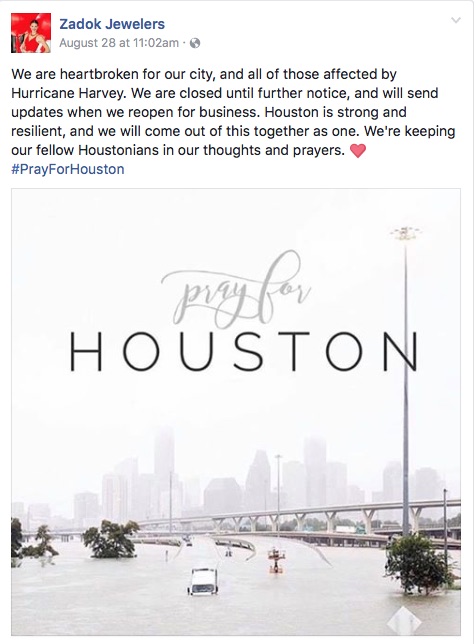Articles and News
Hurricane Preparedness For Jewelers | August 26, 2020 (0 comments)

Merrick, NY—Jewelers in coastal areas are no strangers to hurricanes and likely have a checklist ready to be sure they’re solidly prepared. But in the rush to get everything secured, it’s easy to forget a step. Or, if you’re new to a hurricane-prone area, to not realize everything that’s involved in securing your business.
Here, courtesy of Jewelers Mutual and Berkley Asset Protection, are a collection of tips to make sure your hurricane preparedness checklist is fully rounded out.
Before the storm:
1. As soon as a hurricane watch or warning is broadcast, take immediate action. Even if you’ve been through one before, you never know until it happens whether a storm will be a minor inconvenience or catastrophic. Monitor National Weather Service forecasts. Consult your disaster continuity plan or use the tips below.
2. Complete your storm preparations and leave the area if directed to do so by authorities.
3. Emergency supplies for the store include plywood for windows if you don’t have shutters, mops, brooms, sandbags, tarpaulins to cover key equipment, etc.
4. Test all generators, emergency lighting, sump pumps, etc. Also check any protrusions on your roof (HVAC equipment, skylights, etc. to ensure they’re secure and leak-free. Remove any obstructions to roof gutters, drains, and nearby storm drains in the street to prevent blockage and reduce chances of flooding.
5. Bring in outdoor items that could be picked up by wind, including signs, banners, chairs, even potted plants or gravel.
6. Close windows, doors and hurricane shutters. If you do not have hurricane shutters, board up all windows and doors with plywood. Empty all merchandise from showcases; that glass can shatter as well. Consider protection for those.
7. Turn off propane tanks and unplug small appliances.
8. Store jewelry inventory in the safe. Have a secure place to store jewelry that you don’t normally put into the safe.

The interior of J.R. Dunn in Lighthouse Point, FL, is empty and wrapped up in advance of Hurricane Matthew in 2016.
9. Assure that your computer system is fully backed up. Make a copy of key information (inventory records, repair goods, vendors, contacts) on a flash drive to take with you. Also make hard copies of the most essential information in case you can’t access your digital records.
10. Charge cell phones and download the NOAA Now or NOAA Weather app.
11. Cover computers, machinery, supplies, and other areas with tarps. Avoid storing materials on the floor if water could damage them.
12. Fill your car’s gas tank.
13. Talk with staff members, create an evacuation plan, and be sure to have everyone’s contact information in case of evacuation. Appointing one person to coordinate updates will help avoid message confusion and keep everyone on the same page.
14. In addition to your insurance agent and insurance company, determine the key parties that will help you recover from the damage and keep their numbers handy. These include contractors, vendors, and other business partners. Again, assigning a point person to manage these relationships can help avoid confusion.
15. Because most business insurance doesn’t cover flooding, consider flood insurance through the National Flood Insurance Program, though a policy must be purchased in advance.
Related: First Look At Hurricane Harvey’s Impact On Jewelers

A social media post from Zadok Jewelers following Hurricane Harvey's 2017 destruction in Houston, TX.
After the Storm:
1. Survey for damage, but be sure to avoid loose or dangling power lines and don’t wade into flood waters in case live wires are hidden in it. Call police or fire department or power company to report downed wires.
2. Take pictures of any damage to the buildings and their contents. Take all necessary photos before throwing anything away or beginning cleanup. Secure the building to protect it from further damage or looting.
3. Contact your security company and insurance broker or carrier to report damage and receive advice about next steps. Once you’ve been in contact with your adjustor and get the go-ahead, you begin removing debris as soon as possible and safe to do so.
4. Before utilities are returned to service, check for gas leaks, look for electrical system damage and check for sewage and water line damage.
5. Separate all damaged and undamaged property. This will make it easier to identify the value of the damaged property and protect your undamaged property. Board up any openings to reduce the chances of additional weather damage or criminal trespassing.
6.. Stay tuned to local radio and the National Weather Service for information and try to keep your phone clear for emergency use.
7. After a storm, contractors are in high demand and unscrupulous ones may take advantage of the situation. Only hire a contractor you know and trust.
8. Critique your pre- and post-storm actions to identify strengths and weaknesses and make necessary modifications to prepare for the next emergency. Staying up to date on the condition of your building year-round is a wise way to expedite the process of preparing for a hurricane. If you only check the condition of your roof or building fixtures before a hurricane is forecasted, you may end up discovering there are more repairs that need to made than you possibly have time for.
Jewelers Mutual offers a downloadable Hurricane Preparedness Guide.







